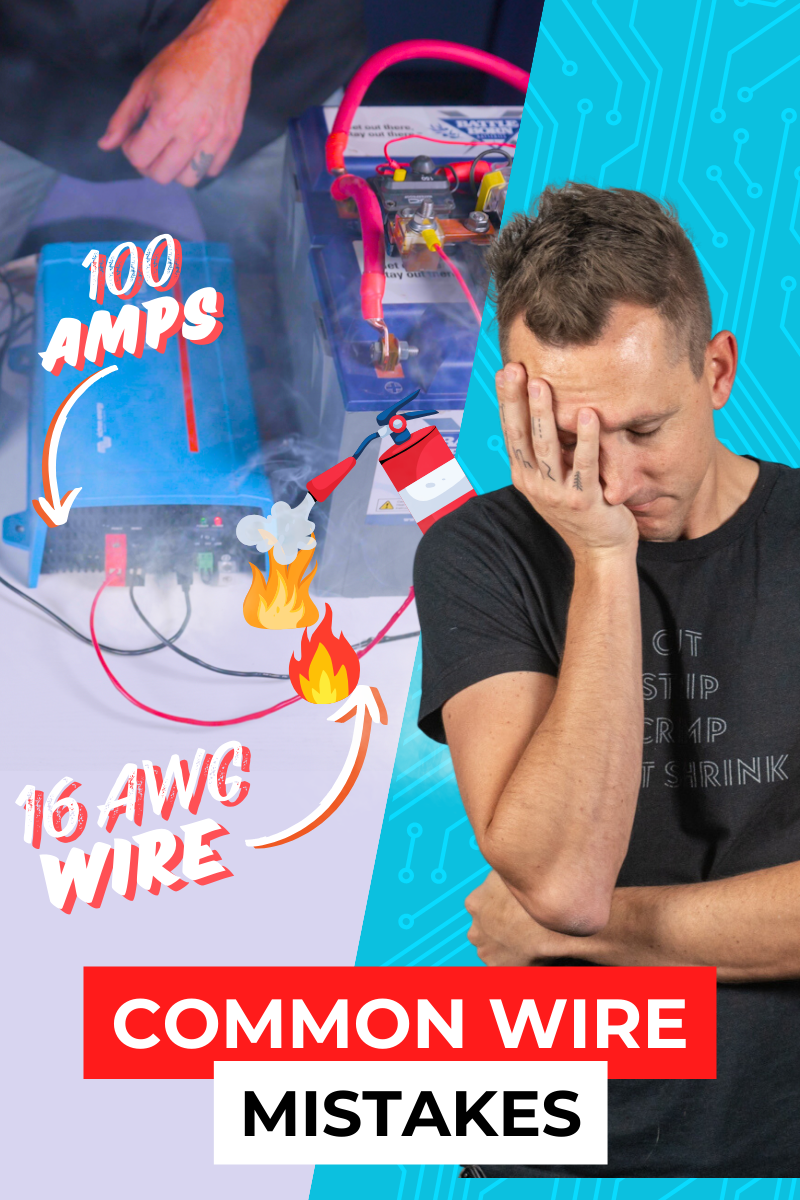I’ve spent the last four lessons of this academy teaching you everything there is to know about wire size, wire insulation, wire ampacity, and more… but what happens when you make poor wire choices?
Common wire mistakes and how to avoid them is exactly what we are going to cover here in lesson #5 of this Wire Basics chapter.

Common Wire Choice Mistakes – VIDEO
Instead of bigger wires, can I use multiple smaller wires?
We see this a lot with big inverters. Some inverter manufacturers supply a ‘dual’ wire instead of a single wire; and if there is enough combined copper inside of both wires added together to carry the power; there’s nothing wrong with this, but… it limits us on fusing. Here’s why:

When you have a dual wire situation like that; the fuse protecting those dual wires cannot be larger than is acceptable for one of the singular wires.
Here’s a specific example:
In this wiring diagram directly from Victron; they have two wires powering a single Victron Multiplus 3kVA 12V inverter charger. Those two wires are protected by a single 400A fuse.

Now; although they don’t list their wire size directly on this diagram; if we hop over into the user manual for that Multiplus; we can see that they have 50mm2 spec’d out for shorter runs; which is equivalent to 1 AWG wire for those of us here in the USA.
High Quality 1 AWG Wire with 105 degree insulation is rated for 245 amps when installed outside of an engine space without any additional derating factors (ABYC E-11 Table 4A)
ABYC E-11.10.1.5.2 says that: Each fuse or trip-free circuit breaker shall be rated in accordance with E-11.10.1.3 and E-11.10.1.4 and shall not exceed 150% of the conductor ampacity in TABLES 4A-B.

This means that… the max fuse size that can protect 1 AWG wire is: 245A x 1.5 = 367A.
So… a single 400A fuse protecting dual 1 AWG wires is actually not allowed per the ABYC.

This is why you see us here at EXPLORIST.life going against manufacturers recommendations in this case in our kits and diagrams and instead, spec’ing out single 4/0 wire (aka 107mm^2 wire) rated to 445A to cover the 100mm2 equivalent of dual 1AWG (50mm^2) wire.

Can I just use wire from my local hardware store?
If you take into account everything I’ve taught you over the last four videos of this academy regarding insulation types, wire ampacities, and derating factors, you technically could do that, but… you’re really going to hate that decision when you go to wire batteries together or wire an inverter with big 4/0 THHN wire that bends about as well as rebar.
4/0 battery wire is rarely sold at standard home improvement stores but is incredibly flexible and easy to work with in tight quarters like all of you watching this video will be working in.
Can I use 4GA wire instead of 4/0 since it’s so much cheaper?
If something requires 4/0 wire; you can’t simply sub in 4ga wire. Remember back from lesson 3.3 of this academy that 4/0 wire is nearly 4x larger than 4ga wire; which is also why it is so expensive.

Remember from lesson 3.3 that wire gets BIGGER as the wire gauge gets smaller but only until we get to 0 AWG where the wire then gets bigger as we start adding zeros.
Confusing, I know… but go back to lesson 3.3 if you need a refresher.
Can I just oversize my wire ‘to be safe’?
Actually, yes. But only to a degree. And you still have to do the math behind the decision to make sure that ‘oversizing’ is ACTUALLY an appropriate wire size.
A specific example here is actually in the wiring kits we sell at shop.explorist.life

You’ll notice that our 50A and 30A charge controller wiring kits both use 6 awg wire. The 6 awg wire math checks out for both applications BUT, the max wire terminal size on the Victron SmartSolar MPPT 100/50 and 100/30 are both 6AWG, so we just consolidate wire sizes on these so that they work for as wide of a customer base as possible.

Upsizing further than 6 AWG for either of these kits would result in the wire not fitting into the terminal of the device, which opens a whole new can of worms.
So yes… oversizing wire can be a good idea, but only if you do it strategically and have some thoughts and justifications behind it.
Conclusion
I hope this helps provide some insight into common problems we see surrounding improper wire choices.
Now; it IS worth mentioning that the system kits and diagrams we sell in our store over at shop.explorist.life have all of the proper wire sizes and types included or figured out for you.
We will refer to wire sizes and types throughout the rest of this academy, so be sure to bookmark this video for future reference and come back to it if you need a refresher.
Now that you know everything there is to know about wire sizes and types; it’s time for the grand finale of our wire basics playlist so I can tie everything together and teach you step-by-step how to choose proper wires and sizes with some real-life examples, and that’s coming up in the next lesson.



